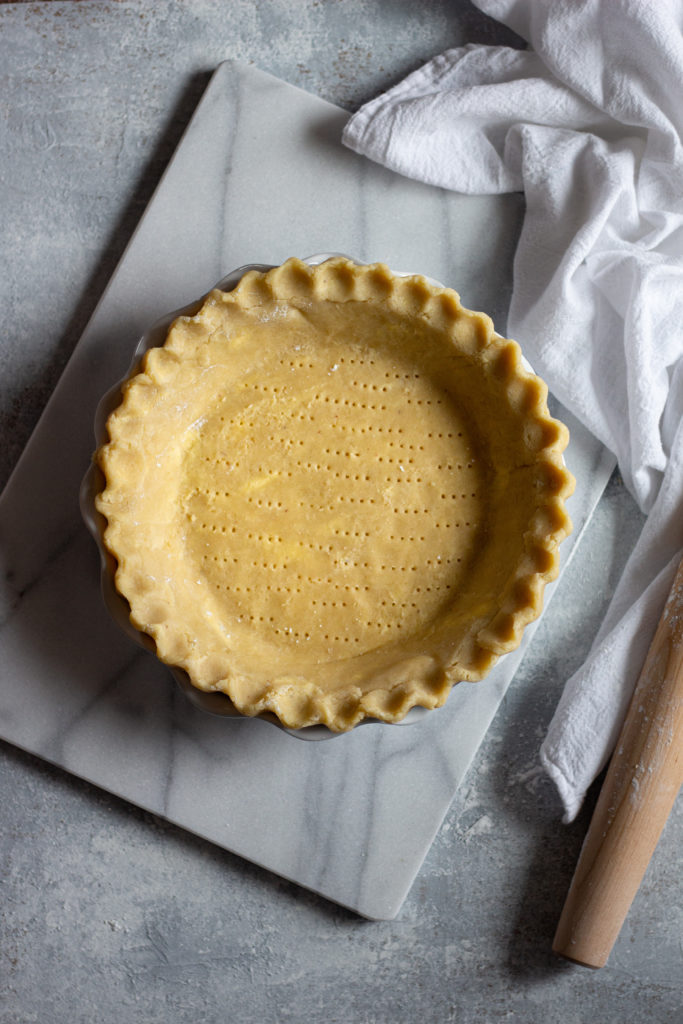
I haven’t had a good pie crust in a while. Maybe that’s why I never make pie. After all, the crust is kind of the best part of pie. Gluten-free pie crust can be tough. And grain-free pie crust can be chewy. <sigh> I pretty much gave up on pie. Why bother?
Then, three different friends all contacted me in one week asking for a pie crust recipe. I directed them to the pie crust recipes I had been using with a note that “they aren’t the best, but they will do.”
Did I really think that was okay? Was it okay to send my friends sub-par pie crust recipes and just give up? NO WAY! I had to make a good pie crust recipe!
Well, after 6 weeks of recipe testing and eight recipe versions later, I have a pie crust I am very pleased with. It is flaky, buttery, the good king of crumbly, and absolutely delicious.
Because friends don’t let friends eat bad pie crust.
Grain-Free Pie Crust
- 140 grams almond flour
- 38 grams Bob’s Red Mill Paleo Baking Flour
- 46 grams tapioca flour
- 1/2 tsp sea salt
- 8 Tbsp grass-fed salted butter, or, 6 Tbsp Miyokos vegan butter and 2 Tbsp palm shortening
- 20 grams tart, plain coconut-milk yogurt (I also like Culina dairy-free yogurt)
- 1 tsp. apple cider vinegar
- 1-2 Tbsp. ice water
Directions to make the pie dough:
- Combine the vinegar and yogurt in a small bowl and set aside.
- Combine the almond flour, Paleo flour, tapioca flour, and sea salt in a large bowl.
- Cut the butter into 1/2 inch cubes. Sprinkle the butter cubes into the flour mixture. Use your hands to crumble the butter into the flour mixture until there are only pea-size pieces of butter throughout.
- Add the yogurt mixture and 1 tablespoon of ice water to the flour mixture.
- Mix the dough with your hands until it is combined and resembles sugar cookie dough. (Only add the additional tablespoon of ice water if the mixture is dry and won’t come together.) Work the dough a bit until it is smooth and all together. Roll the dough into a ball.
- Place the dough on a piece of plastic wrap and flatten it into a disk about 1 1/2 inches thick. Wrap the dough in the plastic wrap and refrigerate it overnight, or, freeze it for 1 hour.
- The crust can be refrigerated for a week, or, frozen for months.
Directions for when you are ready to bake a pie:
- Place a piece of parchment paper on your counter. Sprinkle the parchment paper with a handful of tapioca flour.
- Sprinkle the top of the dough with tapioca flour and roll it out to a 1/4 inch thickness. (If the dough is too crumbly roll it into a ball and re-roll it; you can do this two or three times. Sprinkle with tapioca flour each time you re-roll the pie crust.)
- Lay the pie dough in a pie plate. (It may begin to crack and crumble. Just press it back together with your fingers.) Finish the edges however you like- crimped, fluted, flat, pressed with a fork. Place the pie crust in the freezer for 15 minutes.
- Preheat the oven to 425F.
- Place the pie plate on a baking sheet; this makes it easier to get the pie in and out of the oven and prevents the filling from spilling in your oven.
- Wrap aluminum foil around the edges of the pie crust to prevent it from burning. Blind bake (bake without a filling) for 15 minutes.
- Fill the crust with your desired filling and bake until the filling is cooked. (Remove the foil the final 5 minutes of baking your pie and brush the crust with an egg-wash glaze; this is not necessary, but it makes the crust really beautiful.
Egg-Wash Glaze
- 1 egg yolk
- 2 Tbsp coconut milk (or your favorite unsweetened milk)
Directions for the egg-wash glaze:
- Whisk the egg yolk and milk together until fully combined.
- Brush the egg wash on the edges of the pie crust the last 5 minutes of baking.
You might enjoy filling your pie crust with this Sugar-Free Pumpkin Pie.